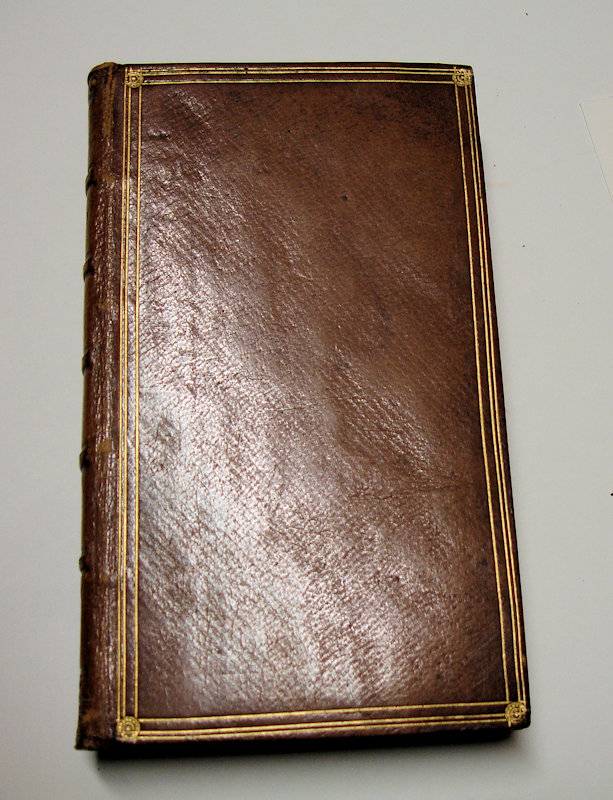HORATIUS.
Quinti Horatii Flacci Carmina, nitori suo restituta. Accurante Steph. And. Philippe.
Paris (Lutetiae Parisiorum), Sumptibus Ant. Urb. Coustelier, 1746. (Colophon at the foot of leaf 2B6v reads: 'Typis viduae Delatour')
Small 8vo. Engraved frontispiece, XXIV,299,(1 blank) p. Calf 15,5 cm (
Ref: Schweiger 2,410; Brunet 3,320; Graesse 3,355; Ebert 10211) (
Details: Nice copy. Back gilt and with 5 raised bands. Boards with tripple fillet gilt borders. Gilt inside dentelles. Edges of the bookblock gilt. Green marbled endpapers. Frontispiece designed by B. Picart, and executed by Cl. Duflos. (Claude-Augustin-Pierre Duflos) It depicts a bucolic scene with in the foreground Venus and little Amor; in the middle a medallion with a portrait of Horace. Printer's mark of the Estiennes on the title, featuring an old man who stands in the shade of a vine-entwined elmtree, symbolising the symbiotic relationship between scholar and publisher. The motto is: 'Non solus'. Woodcut initials, ornaments and engraved vignettes) (
Condition: Some faint wear and scratches to the binding; small inscription on the verso of the first flyleaf) (
Note: The works of the Roman poet Quintus Horatius Flaccus, 65-8 B.C., have enjoyed a continuous presence in European culture. Till well into the 20th century he stood central in school curricula. Earlier, in the Middle Ages, he was next to Vergil the most important school author. Horace is transmitted in around 300 medieval manuscripts. The Renaissance saw the beginning of a flood of editions. 'For Neo-latin poetry until modern times, and for all the vernacular literature of Europe from the 16th through the 18th centuries, Horace provided the dominant model both for private lyrics celebrating wine and love and for public lyrics celebrating affairs of state'. Young poets used Horace to learn the trade. 'Horace's elegant rationalism and moral wisdom, and also his disabused and tolerant tone, made his poems favorite reading during the Enlightenment'. (The Classical Tradition, Cambr. Mass., 2010, p. 454/60)
§ The French historian and geographer Étienne André Philippe de Prétot, 1710-1787, produced in the beginning of his carreer quite a number of editions of Latin classics. Between 1747 and 1755 he edited for the Parisian publisher Antoine-Urbain Coustelier Catullus, Tibullus, Propertius, Sallustius, Vergilius, Horatius, Juvenalis, Persius, Phaedrus, Lucretius, Velleius Paterculus, Eutropius and Terentius. The editions were accompanied by explanatory notes and erudite introductions. (See wikipedia s.v. Philippe de Prétot) Philippe de Prétot based his Horace on the very respectable Parisian edition of the Jesuit Noel-Étienne Sanadon of 1728, who consulted the old commentaries, but chiefly followed Bentley and Cunningham. Especially the latter, adds Dibdin) (
Provenance: On the verso of the front flyleaf in ink: '4 francs, Paris, October 1855' , and in pencil: '26 florins, Amsterdam, Maart 1955') (
Collation: a8, b4; A-Z8/4, 2A4, 2B6) (Photographs on request)
Book number: 120262 Euro 225.00
Keywords: (Oude Druk), (Rare Books), Horace, Horatius, Horaz, Latin literature, antike altertum antiquity, römische Literatur
 HORATIUS.
HORATIUS.